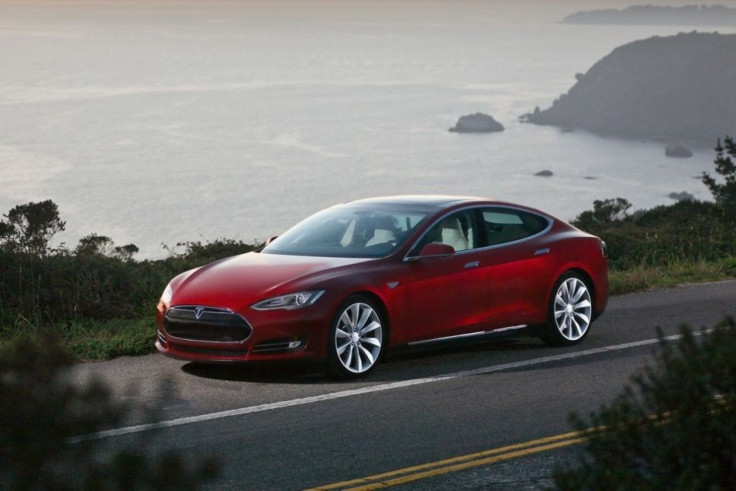Here Are The Four Items In Tesla’s Second Quarter Earnings That Turned A $30.5M Loss Into A $26.2M Profit

Tesla Motors Inc. (NASDAQ:TSLA), the little American electric car company that could, released second-quarter earnings on Wednesday with more footnotes per page than a David Foster Wallace novel.
While nobody expects the maker of the critically acclaimed Model S electric luxury sedan to offer big returns on investment anytime soon – after all, it’s a startup in a highly capital-intensive industry with a high historic failure rate – Tesla’s chairman and CEO Elon Musk is under intense pressure to maintain momentum, and part of that includes utilizing some perfectly legal accounting maneuvers.
“Tesla Shocks Everyone And Reports Surprise Profit,” the popular auto blog Jalopnik gushed on Wednesday afternoon.
“The auto maker, led by founder Elon Musk, reported net income of $26.3 million, excluding one-time items, that handily beat expectations for a loss of $18.9 million,” reported USA Today.
The truth is somewhere in-between. As USA Today suggests, there were one-time items that brought the company income, most of which will never be seen again. There’s also income that under generally accepted accounting principles (GAAP) would not have been as high as Tesla reported this quarter.
Tesla states very clearly at the start of its letter to shareholders that it is offering two perspectives on its performance in the last quarter ending June 30.
“In this letter and going forward, we will report our results on a GAAP basis as well as on a non-GAAP basis,” the letter states. “We believe these non-GAAP financials are useful as they align with the underlying cash-flow activity and timing of vehicle deliveries, and because we use such information internally for operational management and financial planning purposes.”
So how did Tesla turn a loss of $30.5 million into a $26.3 million profit? By including one-time gains and one non-GAAP item. Excluding the one non-GAAP item, the company still turned a profit of about $7 million, but only because its own employees gave it money by exercising stock options. (And this doesn't even address the $51 million Tesla made in the second quarter selling zero emission vehicle credits provided by the state of California.)
Here’s the breakdown of the four items:

1. Thanks to its partnership with U.S. Bancorp (NYSE:USB) and Wells Fargo & Co. (NYSE:WFC), which includes guarantees on the resale value of the Model S, Tesla is getting all of the money upfront for three-year leases. Instead of customers paying Telsa on a regular basis, and then Tesla reporting that income quarterly like auto companies typically do, Tesla received the total sum of these leases in one go from the banks.
As long as Telsa can continue to grow its financing business and has backers willing to provide the income for the life of the leases, the company will be able to continue to report this as quarterly income. If that income had been spread out according to GAAP standards, it would have been about $1.6 million in the second quarter instead of $19.3 million.
2. Tesla earned income in the second quarter on stock-based compensation income. In other words, Tesla paid employees in stock options and then the employees exercised those options. In the first half of the year, Tesla garnered $34.1 million in income from its own employees, up from $23.2 million in the first half of last year.
The Kellogg School of Management at Northwestern University described stock-based compensation as “one of the most enduring controversies in accounting.”
“In a nutshell, managers seem to be more motivated by hitting benchmarks, making their numbers look better,” Ian Gow, assistant professor of business administration at Harvard Business School, said in a research paper in 2011. Before 2006, GAAP standards would have excluded most stock options as income. Tesla reported $19.3 million in the second quarter from its own employees’ stock options.
3. Tesla paid off its U.S. Department of Energy loan nine years early in the past quarter, incurring a fee of $11 million for paying ahead. But it also calculated $16.4 million in income from early loan repayment. This income is clearly an unorganic one-time item.
4. Tesla also made a modest $1.8 million on non-cash interest related to convertible notes.
With these four items, Tesla turned a loss into a gain, but only the leasing deal has anything to do with the organic profit of Tesla, the only one pertaining to making and selling cars.
Not that it matters. The company’s stock price reached an all-time high of $157.86 on Wednesday. Apparently some investors didn't pay attention to the footnotes.
© Copyright IBTimes 2025. All rights reserved.






















